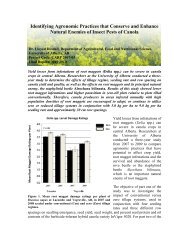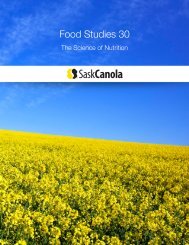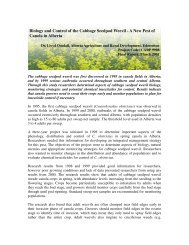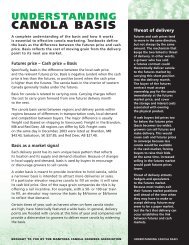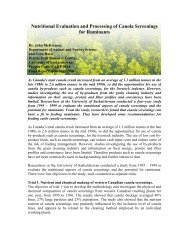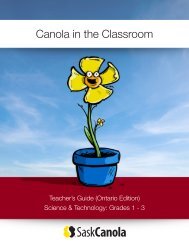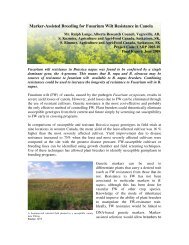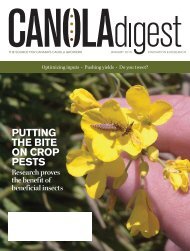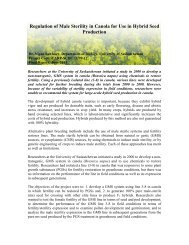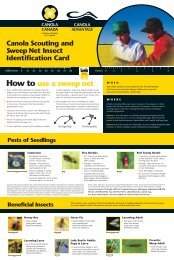Alternative Sulfur Fertilizer Sources for Canola - SaskCanola
Alternative Sulfur Fertilizer Sources for Canola - SaskCanola
Alternative Sulfur Fertilizer Sources for Canola - SaskCanola
Create successful ePaper yourself
Turn your PDF publications into a flip-book with our unique Google optimized e-Paper software.
<strong>Alternative</strong> <strong>Sulfur</strong> <strong>Fertilizer</strong> <strong>Sources</strong> <strong>for</strong> <strong>Canola</strong><br />
Dr. Jeff Schoenau, Department of Soil Science, University of Saskatchewan<br />
Project Code: CARP 9504<br />
Final Report: August 1998<br />
Researchers conducted a field study in 1995 near Star City, Saskatchewan in the Gray<br />
soil zone, which compared the effectiveness of different sulfur <strong>for</strong>ms added as sources<br />
of fertilizer sulfur <strong>for</strong> canola. The research showed a sulfur fertilization rate in the<br />
range of 15-25 kg S/ha was adequate. Powdered elemental sulfur alone was the least<br />
effective and ammonium sulfate was the most effective in increasing sulfur availability<br />
and increasing yield. The waste gypsum sources were nearly as effective as ammonium<br />
sulfate, making it an effective means <strong>for</strong> canola producers to economically increase<br />
sulfur availability in sulfur deficient soils of the Gray soil zone.<br />
<strong>Canola</strong> is a crop with a high demand <strong>for</strong> sulfur, about double the requirements of cereals.<br />
Without adequate available sulfur in the soil, severe yield losses can occur in canola.<br />
There<strong>for</strong>e, sulfur is routinely added to the fertilizer blend, even in soils that test relatively<br />
high in plant available sulfur. In the mid 1990s, the two main <strong>for</strong>ms of sulfur fertilizers<br />
used in western Canada were elemental sulfur products and ammonium sulfate. However,<br />
other sulfur sources existed in western Canada that had not been explored <strong>for</strong> their<br />
potential value as sulfur fertilizers <strong>for</strong> crop production.<br />
Researchers at the University of Saskatchewan conducted a field study in 1995 near Star<br />
City, Saskatchewan in the Gray soil zone, which compared the effectiveness of different<br />
sulfur <strong>for</strong>ms added as sources of fertilizer sulfur <strong>for</strong> canola. The objective of the study<br />
was to evaluate the effectiveness of two sulfur fertilizer product concepts: powdered<br />
elemental sulfur mixed with sewage sludge and lime; and waste wallboard and mining<br />
gypsum in comparison with powdered elemental sulfur alone and standard fertilizer grade<br />
ammonium sulfate. In the study, the sources were compared and assessments were made<br />
of differences in plant sulfur concentration and uptake, residual soil sulfate and yield<br />
response.<br />
Six different sulfur fertilizers were prepared <strong>for</strong> the experiment, and each product was<br />
applied at four different sulfur application rates of 0, 20, 40 and 80 kg S/ha. Ammonium<br />
nitrate was added to each plot to ensure that N deficiency did not limit yield. The plot had<br />
also received anhydrous ammonia at a rate of 100 lb N/acre the previous fall. The sulfur<br />
fertilizers were broadcast and incorporated on May 9, and one week later plots were<br />
seeded to Argentine canola (var. Garrison) using an International 7400 drill.
Overall, a significant increase in mid-season dry matter yield was observed in response to<br />
increasing rates of sulfur fertilizer. However, rates of sulfur above 20 kg S/ha did not<br />
result in significant increases in final grain and straw yield, but did result in increased<br />
sulfur uptake and accumulation of residual sulfate in the soil. There<strong>for</strong>e, it appears that a<br />
sulfur fertilization rate in the range of 15-25 kg S/ha would be satisfactory in ensuring<br />
adequate sulfur nutrition of the canola crop under conditions present. (Table 1) and<br />
(Table 5).<br />
In the year of application, powdered elemental sulfur alone was the least effective in<br />
increasing sulfur availability and yield of canola, and ammonium sulfate was most<br />
effective. The observed lower sulfur availability and yield response from the elemental<br />
sulfur source is due to incomplete conversion of the elemental sulfur to the plant<br />
available sulfate <strong>for</strong>m in the soil in the year of application. The waste gypsum sources<br />
per<strong>for</strong>med nearly as well as the ammonium sulfate, pointing to the possibility of using<br />
such sources of sulfur as another means to increase soil sulfur availability in the Gray soil<br />
zone. The elemental sulfur sources resulted in yield increases of approximately 0.2 T/ha<br />
compared with yield increases approaching 0.4 T/ha with the ammonium sulfate and<br />
gypsum sources. (Table 5)<br />
Overall, the waste gypsum sources evaluated in this project could be an effective means<br />
<strong>for</strong> canola producers to economically increase sulfur availability in sulfur deficient soils<br />
of the Gray soil zone. Other product possibilities include the combination of powdered<br />
elemental sulfur with lime and sewage sludge to produce a pellet or wafer of high sulfur<br />
analysis, which can be easily handled and applied, but also oxidizes relatively rapidly.<br />
Such products may be worthwhile considering <strong>for</strong> producers who desire a slow release<br />
type of sulfur source that is applied once at a high rate and then slowly released into<br />
available <strong>for</strong>ms over a number of years.<br />
Note: Scroll to page 3 to view Table 1 and page 4 to view Table 2.
Table 1. Average values <strong>for</strong> mid-season biomass and final grain and straw yield as<br />
related to sulfur rate and source.<br />
Dry Matter Production<br />
Rate Mid Season Grain Straw<br />
T ha -1<br />
20 2.68 1.85 5.11<br />
40 2.76 1.89 5.16<br />
80 3.25 1.88 5.48<br />
LSD (0.05) 0.36 NS † NS †<br />
S Source Mid Season Grain Straw<br />
T ha -1<br />
Control †† 2.13 1.63 4.90<br />
S° 2.79 1.78 4.85<br />
S° Mixture 2.90 1.79 5.14<br />
S° + Lime 2.99 1.85 5.12<br />
Wallboard<br />
Gypsum 3.09 2.02 5.60<br />
Gypsum Ore 3.08 2.02 5.44<br />
Ammonium<br />
Sulfate 3.28 2.03 5.72<br />
LSD (0.05) 0.56 NS † NS †<br />
† F value <strong>for</strong> the model not significant.<br />
†† Control treatments consists of ammonium nitrate application equivalent to<br />
N supplied by ammonium sulfate.
Table 2. Average residual soil sulfate levels (end of season)<br />
and sulfur fertilizer use efficiency (SUE) as related to sulfur<br />
rate and source.<br />
Rate SO 4 -S SUE<br />
____kg ha -1 ____ ______%______<br />
20 9.8 51.5<br />
40 12.4 22.2<br />
80 27.1 12.5<br />
LSD (0.05) 2.12 9.49<br />
S Source SO 4 -S SUE<br />
____kg ha -1 ____ ______%______<br />
Control †† 8.2 -<br />
S° 11.5 19.3<br />
S° Mixture 12.0 19.4<br />
S° + Lime 12.7 14.4<br />
Wallboard<br />
Gypsum 19.8 36.1<br />
Gypsum Ore 21.1 32.8<br />
Ammonium<br />
Sulfate 29.7 50.7<br />
LSD (0.05) 3.24 13.42<br />
†† Control treatments consists of ammonium nitrate<br />
application equivalent to N supplied by ammonium sulfate.



